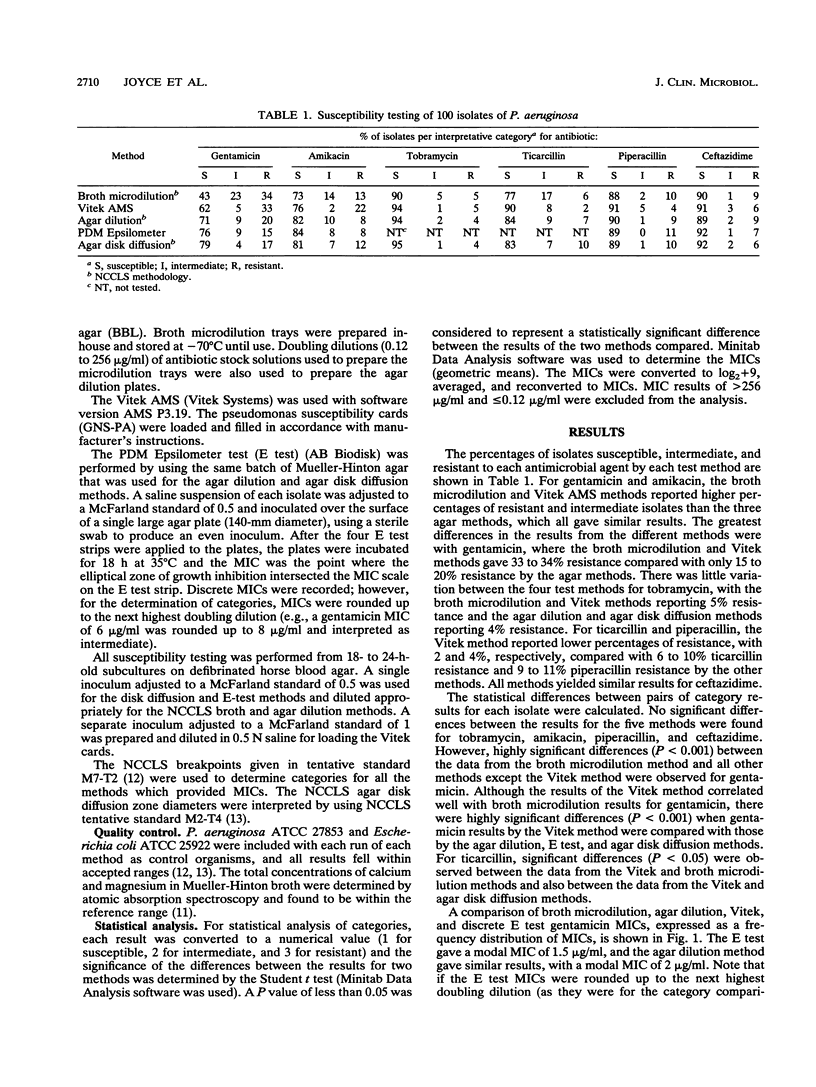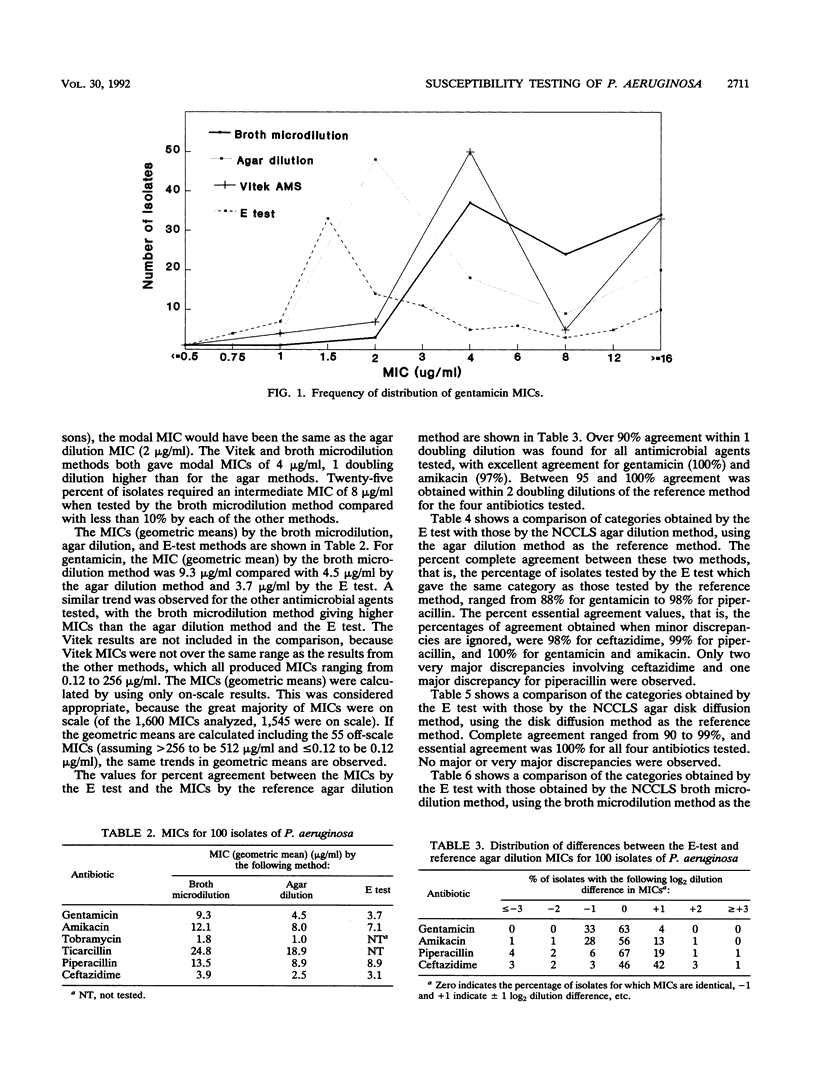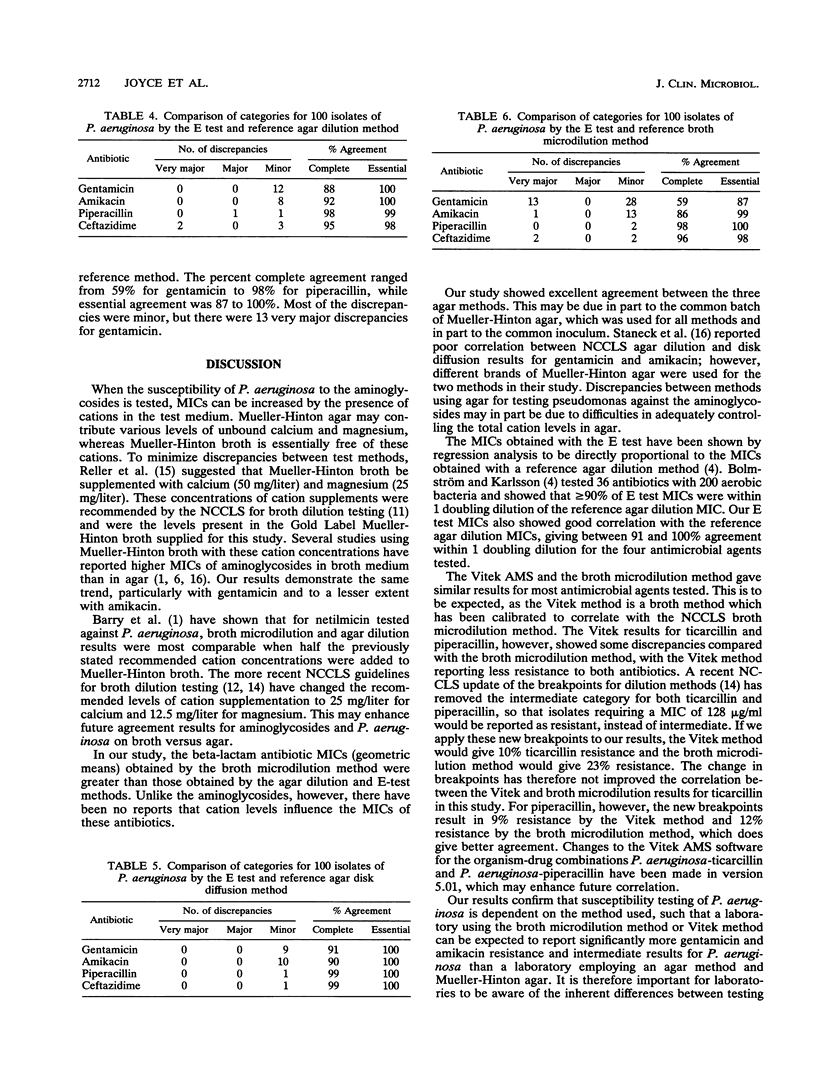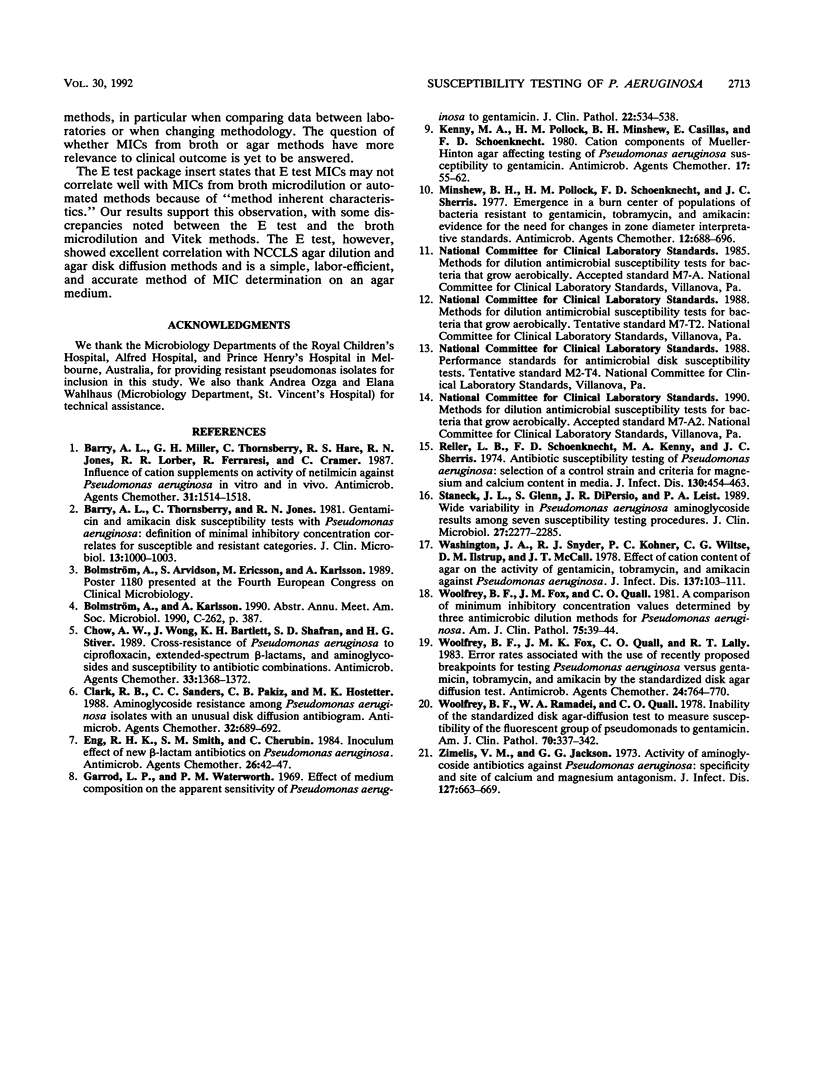Abstract
The antimicrobial susceptibilities of 100 clinical isolates of Pseudomonas aeruginosa to six antipseudomonal antibiotics were tested by five methods: the National Committee for Clinical Laboratory Standards (NCCLS) methods for broth microdilution, agar dilution, and agar disk diffusion; the Vitek Automicrobic System method (Vitek Systems, Hazelwood, Mo.); and the PDM Epsilometer test (E test) (AB Biodisk, Solna, Sweden). The E test results showed excellent correlation with agar dilution results, with over 90% agreement within 1 doubling dilution between the E test and reference agar dilution MICs for all antimicrobial agents tested. The E test results also showed good correlation with the results from the reference agar disk diffusion method, with 90 to 99% complete agreement and 100% essential agreement on categories for all antibiotics tested (essential agreement is the agreement obtained when minor discrepancies are ignored). Comparison of categories with the E test and broth microdilution methods, using the broth microdilution method as the reference method, gave only 59% complete agreement for gentamicin, with 28 minor discrepancies and 13 very major discrepancies. Some discrepancies were observed between results from the E test and broth methods for gentamicin, with the broth microdilution and Vitek methods giving higher MICs than the E test and other methods using agar. The most recent NCCLS guidelines for broth dilution testing have reduced the recommended levels of cation supplementation, which may enhance future agreement between results for the aminoglycosides and P. aeruginosa on broth and on agar. We found that the E test offers a simple, labor-efficient, and accurate method for MIC determination on an agar medium.
Full text
PDF




Selected References
These references are in PubMed. This may not be the complete list of references from this article.
- Barry A. L., Miller G. H., Thornsberry C., Hare R. S., Jones R. N., Lorber R. R., Ferraresi R., Cramer C. Influence of cation supplements on activity of netilmicin against Pseudomonas aeruginosa in vitro and in vivo. Antimicrob Agents Chemother. 1987 Oct;31(10):1514–1518. doi: 10.1128/aac.31.10.1514. [DOI] [PMC free article] [PubMed] [Google Scholar]
- Barry A. L., Thornsberry C., Jones R. N. Gentamicin and amikacin disk susceptibility tests with Pseudomonas aeruginosa: definition of minimal inhibitory concentration correlates for susceptible and resistant categories. J Clin Microbiol. 1981 May;13(5):1000–1003. doi: 10.1128/jcm.13.5.1000-1003.1981. [DOI] [PMC free article] [PubMed] [Google Scholar]
- Chow A. W., Wong J., Bartlett K. H., Shafran S. D., Stiver H. G. Cross-resistance of Pseudomonas aeruginosa to ciprofloxacin, extended-spectrum beta-lactams, and aminoglycosides and susceptibility to antibiotic combinations. Antimicrob Agents Chemother. 1989 Aug;33(8):1368–1372. doi: 10.1128/aac.33.8.1368. [DOI] [PMC free article] [PubMed] [Google Scholar]
- Clark R. B., Sanders C. C., Pakiz C. B., Hostetter M. K. Aminoglycoside resistance among Pseudomonas aeruginosa isolates with an unusual disk diffusion antibiogram. Antimicrob Agents Chemother. 1988 May;32(5):689–692. doi: 10.1128/aac.32.5.689. [DOI] [PMC free article] [PubMed] [Google Scholar]
- Eng R. H., Smith S. M., Cherubin C. Inoculum effect of new beta-lactam antibiotics on Pseudomonas aeruginosa. Antimicrob Agents Chemother. 1984 Jul;26(1):42–47. doi: 10.1128/aac.26.1.42. [DOI] [PMC free article] [PubMed] [Google Scholar]
- Garrod L. P., Waterworth P. M. Effect of medium composition on the apparent sensitivity of Pseudomonas aeruginosa to gentamicin. J Clin Pathol. 1969 Sep;22(5):534–538. doi: 10.1136/jcp.22.5.534. [DOI] [PMC free article] [PubMed] [Google Scholar]
- Kenny M. A., Pollock H. M., Minshew B. H., Casillas E., Schoenknecht F. D. Cation components of Mueller-Hinton agar affecting testing of Pseudomonas aeruginosa susceptibility to gentamicin. Antimicrob Agents Chemother. 1980 Jan;17(1):55–62. doi: 10.1128/aac.17.1.55. [DOI] [PMC free article] [PubMed] [Google Scholar]
- Minshew B. H., Pollock H. M., Schoenknecht F. D., Sherris J. C. Emergence in a burn center of populations of bacteria resistant to gentamicin, tobramycin, and amikacin: evidence for the need for changes in zone diameter interpretative standards. Antimicrob Agents Chemother. 1977 Dec;12(6):688–696. doi: 10.1128/aac.12.6.688. [DOI] [PMC free article] [PubMed] [Google Scholar]
- Reller L. B., Schoenknecht F. D., Kenny M. A., Sherris J. C. Antibiotic susceptibility testing of Pseudomonas aeruginosa: selection of a control strain and criteria for magnesium and calcium content in media. J Infect Dis. 1974 Nov;130(5):454–463. doi: 10.1093/infdis/130.5.454. [DOI] [PubMed] [Google Scholar]
- Staneck J. L., Glenn S., DiPersio J. R., Leist P. A. Wide variability in Pseudomonas aeruginosa aminoglycoside results among seven susceptibility testing procedures. J Clin Microbiol. 1989 Oct;27(10):2277–2285. doi: 10.1128/jcm.27.10.2277-2285.1989. [DOI] [PMC free article] [PubMed] [Google Scholar]
- Washington J. A., 2nd, Snyder R. J., Kohner P. C., Wiltse C. G., Ilstrup D. M., McCall J. T. Effect of cation content of agar on the activity of gentamicin, tobramycin, and amikacin against Pseudomonas aeruginosa. J Infect Dis. 1978 Feb;137(2):103–111. doi: 10.1093/infdis/137.2.103. [DOI] [PubMed] [Google Scholar]
- Woolfrey B. F., Fox J. M., Quall C. O. Comparison of minimum inhibitory concentration values determined by three antimicrobic dilution methods for Pseudomonas aeruginosa. Am J Clin Pathol. 1981 Jan;75(1):39–44. doi: 10.1093/ajcp/75.1.39. [DOI] [PubMed] [Google Scholar]
- Woolfrey B. F., Fox J. M., Quall C. O., Lally R. T. Error rates associated with the use of recently proposed breakpoints for testing Pseudomonas aeruginosa versus gentamicin, tobramycin, and amikacin by the standardized disk agar diffusion test. Antimicrob Agents Chemother. 1983 Nov;24(5):764–770. doi: 10.1128/aac.24.5.764. [DOI] [PMC free article] [PubMed] [Google Scholar]
- Woolfrey B. F., Ramadei W. A., Quall C. O. Inability of the standardized disk agar-diffusion test to measure susceptibility of the fluorescent group of pseudomonads to gentamicin. Am J Clin Pathol. 1978 Sep;70(3):337–342. doi: 10.1093/ajcp/70.3.337. [DOI] [PubMed] [Google Scholar]
- Zimelis V. M., Jackson G. G. Activity of aminoglycoside antibiotics aganst Pseudomonas aeruginosa: specificity and site of calcium and magnesium antagonism. J Infect Dis. 1973 Jun;127(6):663–669. doi: 10.1093/infdis/127.6.663. [DOI] [PubMed] [Google Scholar]


